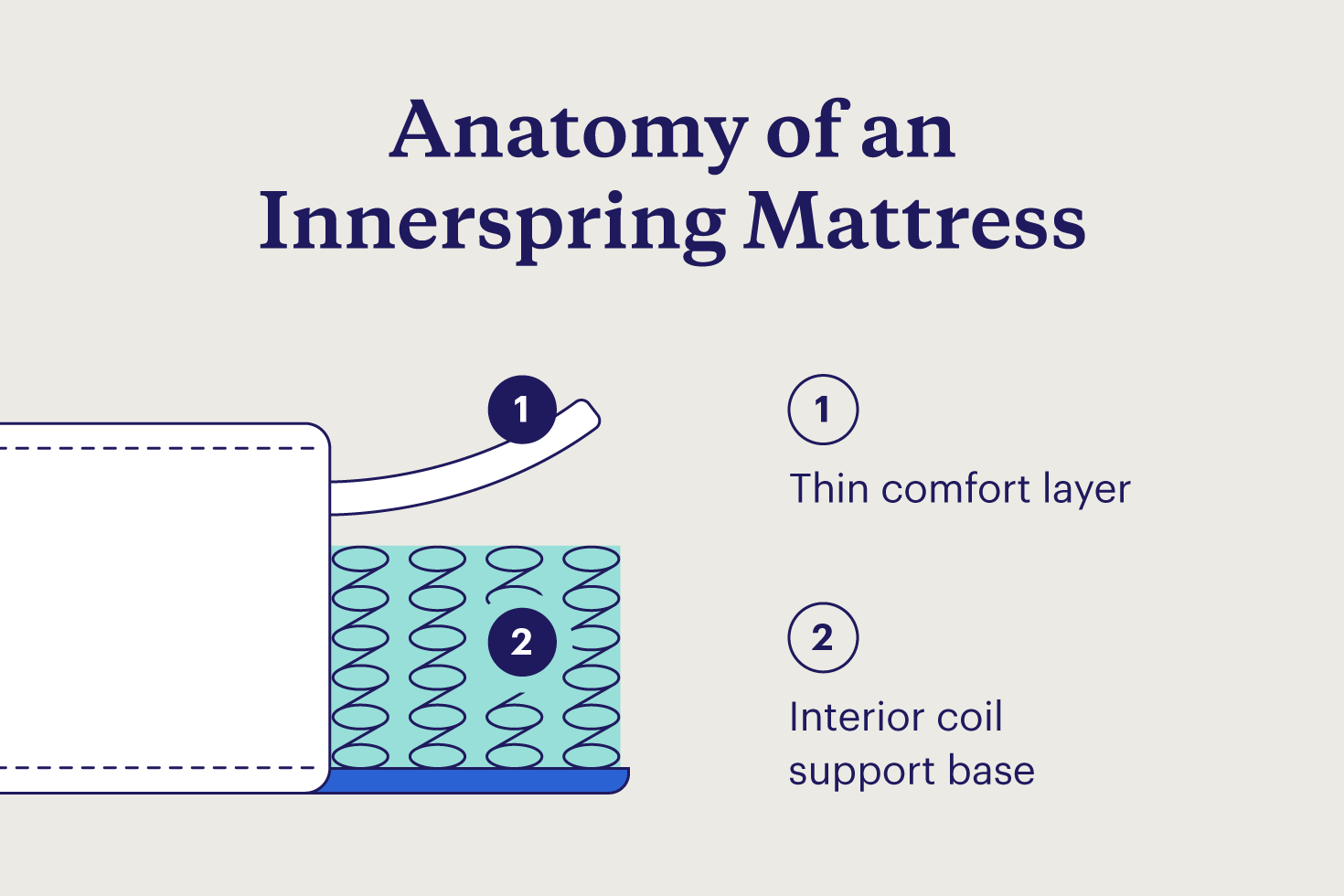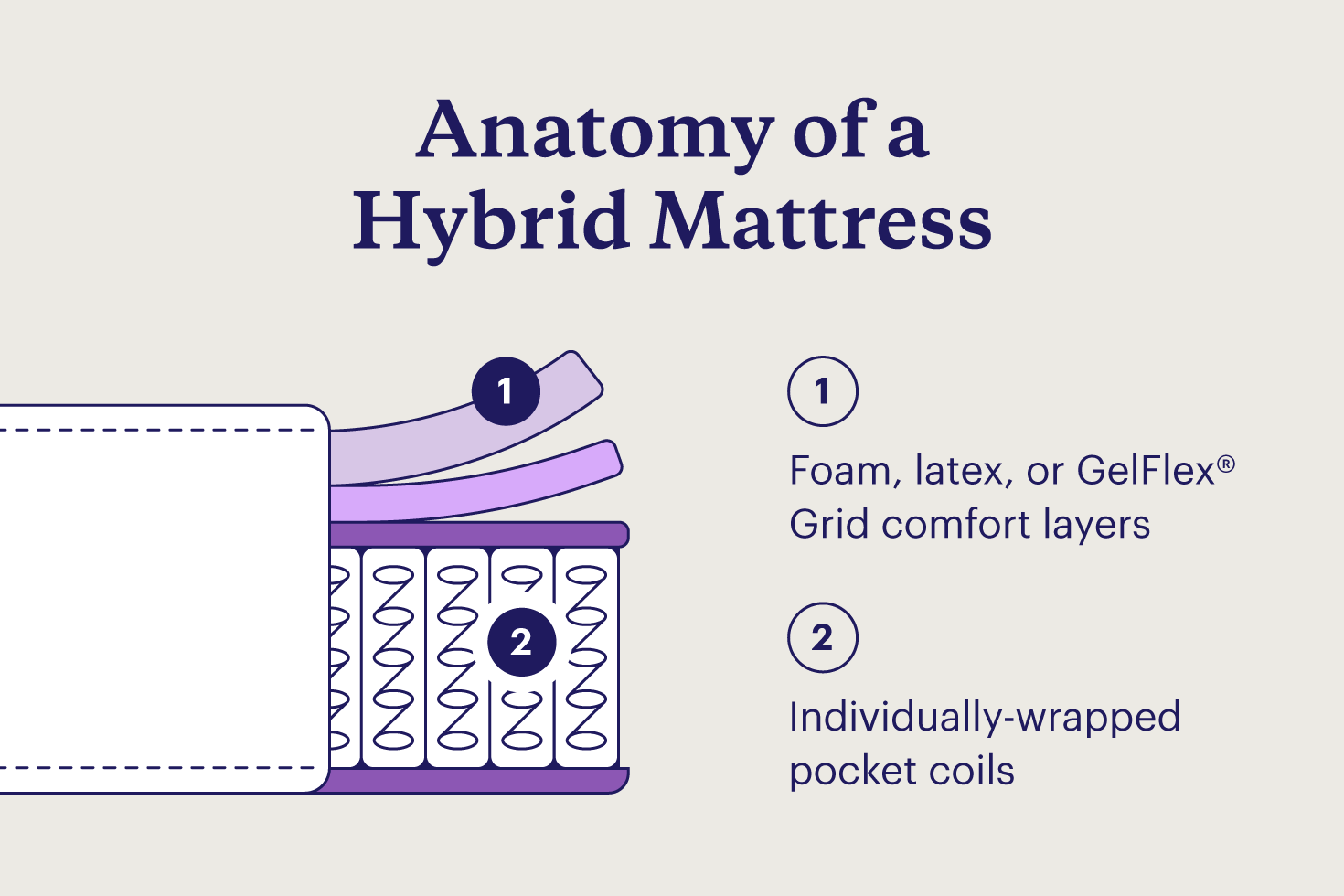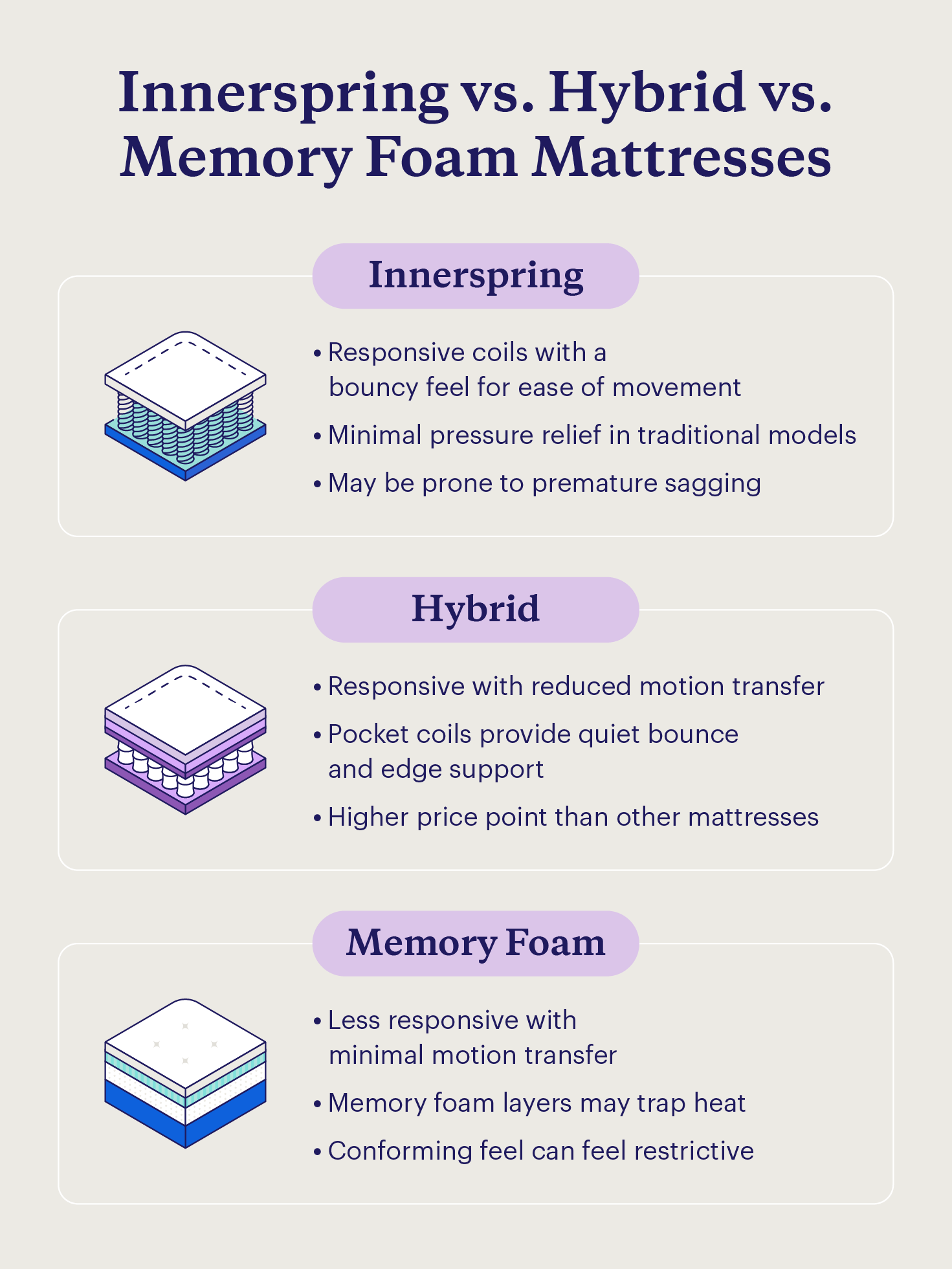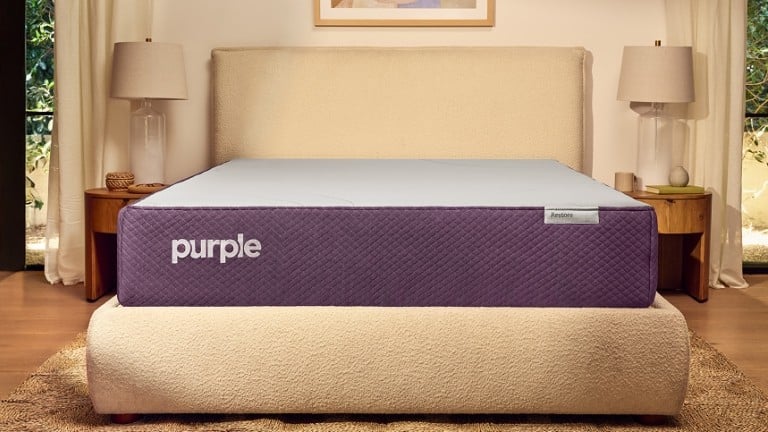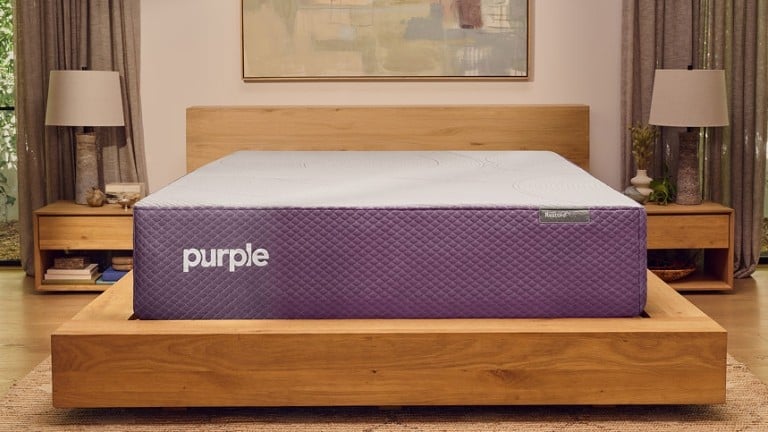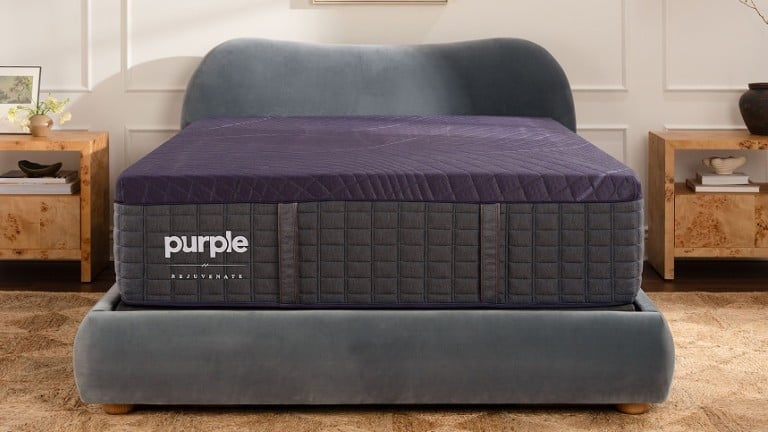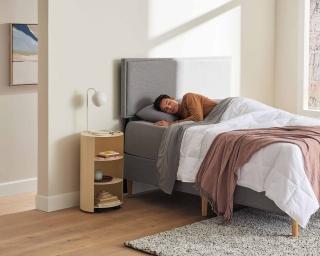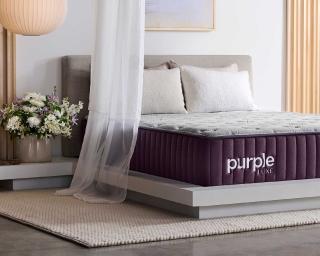Hybrid vs. Innerspring Mattress: Which Is Better For You?
Key Takeaways
- Innerspring mattresses are affordable, with an inner coil structure for support and a thin comfort layer on the outside.
- Hybrid mattresses feature a pocket coil structure with added comfort layers at a higher price point.
- While both innerspring and hybrid mattresses are responsive and support spinal alignment, hybrid options may provide enhanced pressure relief and motion isolation.
If you’re in the market for a new bedroom setup, you may not know how to choose the best mattress for your needs. The type of mattress you choose should ultimately depend on your specific preferences regarding support, comfort, and sleep quality.
When comparing hybrid vs. innerspring mattresses, the differences are widespread: from bouncy and body-conforming to heavily cushioned and responsive. Each model within each category will offer its own set of advantages and drawbacks.
In this guide, we provide an inside look into what sets hybrid and innerspring mattresses apart. Keep reading to decide which of these mattress types is right for you.
What Is an Innerspring Mattress?
A traditional innerspring mattress features a coil support base and a thin comfort layer that combine to create a bouncy sleep surface. This mattress type is usually available in various coil gauges and coil counts that impact comfort and support.
If you’re looking for more comfort, look for innerspring mattresses with these top layers:
- Pillow top: A traditional pillow top is an added layer that is sewn onto the top of the mattress with a visible separation around the perimeter.
- Euro top: When the pillow top and mattress layers appear seamless, this layer is called a Euro top, meaning the comfort layer is sewn into the mattress rather than on top of it.
Innerspring Mattress Construction
Innerspring mattresses are available with three different coil systems:
- Pocketed coils: These thin-gauge coils are wrapped in foam or fabric to isolate motion and are typically the most expensive coil system.
- Continuous coils: These single-length wires are molded into a series of coils, providing overall durability but potentially sacrificing motion isolation.
- Bonnell coils: These hourglass-shaped wires are durable but tend to carry motion across the mattress.
Pros and Cons of Innerspring Mattresses
Pros | Cons |
One of the most affordable mattress types | Minimal pressure relief |
Breathable design for better airflow | Less motion isolation than hybrid options |
Lighter than most hybrid mattresses | Prone to sagging with wear and tear |
Easy to find in showrooms, stores, and online | May accumulate allergens like dust and fur more than a hybrid bed |
Generally require a box spring |
Compared to other mattresses, innerspring mattresses have a famously high firmness level and are some of the bounciest and most breathable options. Consider the advantages and drawbacks before deciding to buy.
Advantages
- Breathability: Hot sleepers are in luck — traditional innerspring mattresses have thin layers that allow air to pass through seamlessly.
- Availability: Compared to their hybrid counterparts, innerspring mattresses may be more readily available in showrooms and furniture stores.
- Affordability: If you’re on a budget, innerspring mattresses usually cost less than $1,000 making them an affordable option.
- Easy to move: From moving rooms to changing sheets, the lightweight nature of innerspring mattresses makes movement of all kinds simple.
Drawbacks
- Limited pressure relief: Thin comfort layers are unlikely to conform to your body like other mattresses.
- Requires box spring: Most innerspring mattresses need a box spring for support and stability to prevent premature sagging.
- Needs to be flipped and rotated: Innerspring mattresses will deteriorate without proper care, so you should plan to regularly flip and rotate your mattress.
- Lack of motion isolation: Coils can transfer motion easily, and innerspring beds tend to be noisier than other options.
- Prone to sagging: Innerspring mattresses are prone to sagging with normal use.
- Allergen-prone: While some innerspring mattresses are hypoallergenic, most aren’t designed to filter out dust, dirt, pollen, hair, fur, and other bedroom allergens.
Who Should Sleep on an Innerspring Mattress?
Innerspring mattresses may appeal to a limited range of sleepers, including:
- Stomach sleepers: A firm innerspring mattress can prevent back and neck pain for stomach sleepers whose weight is distributed from the abdomen.
- Hot sleepers: Innerspring coil mattresses promote airflow and ventilation, distributing body heat and keeping moisture from becoming trapped.
- Plus size sleepers: Heavyweight sleepers who dislike the sensation of sinking into a mattress may find an innerspring mattress provides optimal comfort.
Because of their firmer construction, innerspring mattresses may not suit smaller sleepers who want a more contoured-to-the-body feel. Side sleepers might also struggle with the lack of pressure relief and can wake up feeling sore and stiff.
What Is A Hybrid Mattress?
Hybrid mattresses contain an innerspring support system with memory or latex foam on top. Hybrid mattresses are designed to be ergonomic, conforming to your body shape to relieve pressure.
Hybrid Mattress Construction
Compared to other types of mattresses, hybrid mattresses typically have multiple layers, such as:
- Base layer: This layer contains high-density polyfoam under pocketed coils to provide thorough shock absorption.
- Core support structure: A hybrid mattress’s base support structure is its coil system, individually wrapped in fabric or foam to minimize motion transfer.
- Transition layer: Hybrid mattresses with a transition layer use polyfoam to reduce pressure, increase durability, and help the mattress adapt to changing sleep positions.
- Comfort layer: The comfort layer is typically made from two to three inches of latex or memory foam to provide cushioning and body contouring.
Pros and Cons of Hybrid Mattresses
Pros | Cons |
Combines cushioning comfort layers with a supportive coil structure | Higher price point than innerspring beds |
Minimal motion transfer with plenty of edge support | May be prone to sagging over time |
Designed to promote airflow and respond to your movements | Some of the heaviest mattresses on the market |
Hybrid mattresses combine the stability of innerspring mattresses and the flexibility of a foam mattress. But that doesn’t mean they’re right for everyone. Consider all benefits and potential downsides before committing to a hybrid bed.
Advantages
- May improve posture: Regardless of your favorite sleeping position, hybrid mattresses can adapt to your body, providing support for healthy spinal alignment as you sleep.
- Reduce motion transfer: A thick, cushioning top layer and an intricate coil support system provide superior motion isolation.
- Versatile compatibility: Hybrid mattresses don’t usually require box spring support and will fit into many bed bases, from metal to slatted platform beds to floor mats.
- Ideal for shared sleeping: For anyone who has struggled to sleep in the same bed as a partner, hybrid mattresses provide advanced weight distribution that helps minimize motion transfer and prevent you from feeling stiff or uncomfortable.
- Dedicated edge support: If you toss and turn in your sleep, a hybrid mattress’ edge support system can prevent you from rolling off the bed as well as make it easier to get in and out of bed.
- Cooling: Hybrids have an airy design that allows air to pass through, eliminating heat and moisture for hot sleepers.
Drawbacks
- High price: Depending on size and materials, expect hybrid mattresses to cost between $700 and $5,000.
- Sagging potential: Hybrids contain intricate coil structures and have the potential to sag and wear down more quickly. Most mattress warranties cover sagging, but this policy depends on where you purchase your hybrid.
- Heavier weight: When lifting a hybrid mattress, you may think that nothing could possibly weigh more. Changing your sheets or rearranging your bedroom can become troublesome if you live alone or have difficulty lifting heavy objects.
- Can’t flip: Hybrid mattresses are designed to keep comfort layers on top and the coil support layer on the bottom, unlike some innerspring mattresses.
Who Should Sleep on a Hybrid Mattress?
Hybrid mattresses are ideal for a broader range of sleepers compared to innerspring or foam mattresses. We recommend them for:
- Back sleepers: Hybrid mattresses naturally conform to spinal curves and provide excellent lumbar support, with coil layers that promote spinal alignment and prevent joint pain.
- Stomach sleepers: Medium-firm hybrids with coil support keep stomach sleepers from sinking and misaligning the spine.
- Side sleepers: Side sleepers will love the thick comfort layers of hybrid mattresses with enough pushback to keep their hips and shoulders aligned.
- Combination sleepers: Responsive pocket coils help combination sleepers change positions throughout the night.
- Couples: Pocket coils help reduce motion transfer for couples that tend to toss and turn.
Looking for the best hybrid mattresses on the market? The Purple Restore® Hybrid Collection combines the revolutionary GelFlex® Grid with pocketed coils and zoned support for full-body comfort that lasts all night long. Whether you are looking for a hybrid mattress in a box or the best mattress for lower back pain, Purple has you covered.
Innerspring vs. Hybrid: How They Compare
When comparing hybrid and traditional innerspring mattresses, you’ll find that the core differences lie in design, features, and price. Ultimately, you’ll decide between these options by determining your needs, preferences, and budget.
Feel and Firmness
Generally, hybrids are softer mattresses, while innerspring beds tend to fall on the firmer side of the mattress firmness scale. Both types of mattresses are available in various firmness levels, so you can often find a suitable option depending on which mattress type you prefer.
Mattress feel can also affect your comfort. Where innerspring mattresses are traditionally bouncy thanks to the coil support system, hybrid mattresses cushion the bounce with pocket coils and comfort layers, resulting in a more responsive feel.
Pressure Relief
Hybrid mattresses tend to have much thicker comfort layers than innerspring beds, which can provide a more contoured feel for enhanced pressure relief. Innerspring mattresses with pillow tops may be more comfortable, but these beds may not provide enough targeted pressure point relief for some sleepers.
Spinal Alignment
If you suffer from lower back pain, you may find more firmness options for innerspring mattresses, but a firm mattress may not be better for your back. Some hybrids also come with relief-specific options, like zoned support and adaptive materials to cradle your joints. Medium-firm mattresses, like many hybrids, may offer better support for your back and help keep your spine aligned.1
Body Weight Support
Depending on your body, different mattresses may feel more comfortable and supportive. Based on your weight, you may prefer a hybrid or innerspring mattress for comfort, support, and ease of movement.
- Lightweight sleepers (under 130 lbs): Hybrid mattresses’ memory foam or latex layers keep petite sleepers comfortable, and the coil support layer provides a little bounce to make shifting positions easier.
- Average weight sleepers (130 to 230 lbs): Most sleepers with an average size can choose either option depending on their sleep position, budget, and preferences.
- Heavyweight sleepers (over 230 lbs): Heavier sleepers may appreciate how hybrid mattresses prevent execessive sinking while offering ample support and pressure relief. But an innerspring bed may be better for heavier sleepers who prefer sleeping on top of — not sinking into — their mattress.
Before you choose a mattress, be sure to consider the mattress weight limit; most double beds can safely support the combined weight of two adult sleepers, but verifying any warranties or restrictions can help you choose a durable mattress with a lower chance of prematurely sagging.
Sleep Position Comfort
Your pressure relief and spinal alignment needs may vary depending on your preferred sleep position. If you’re choosing between a hybrid and an innerspring mattress, consider how each will support the way you sleep.
- Side sleepers: For side sleepers, keeping hips and shoulders aligned while relieving pressure from those sensitive areas is key. Hybrids may offer more relief and spinal alignment support than an innerspring bed.
- Stomach sleepers: Firm mattresses can be best for stomach sleepers to prevent spinal misalignment; innerspring and hybrid beds are worth considering.
- Back sleepers: Back sleepers need full-body support to keep their spines aligned, as well as enough cushioning to relieve pressure from their hips, making hybrid beds the better option for most back sleepers.
- Combination sleepers: Sleepers who change positions need a responsive bed that makes moving easier. While an innerspring bed has plenty of bounce, its lack of motion isolation makes it less appealing to combination sleepers.
Temperature Balancing
While both mattresses can be ideal for hot sleepers, innerspring beds have fewer layers, making them more breathable than most hybrids. Ultimately, a mattress’s temperature-balancing qualities depend on its construction and materials, so some hybrid mattresses may have better airflow than others.
The Purple RestorePremier™ Hybrid Mattress sleeps up to 4x cooler than other mattresses, according to a thermal test and heat flux study conducted on Purple hybrid mattresses in 2023. With CoolFlex™ Coils and the GelFlex® Grid, this hybrid mattress promotes better airflow for a temperature-neutral sleep environment.
Motion Isolation
For active sleepers, an innerspring bed can make it easier to shift positions, but it also allows plenty of noisy motion transfer, making it hard for sleeping couples to sleep without interruption. Comparatively, hybrid mattresses feature pocket coils and additional layers to reduce motion transfer and minimize the creaks that come with a traditional innerspring bed.
Durability
You’ll likely need to replace your mattress less often if you opt for a hybrid over an innerspring. While traditional innerspring mattresses have a fairly simple construction and may be prone to premature sagging, hybrid mattresses feature additional layers for support, comfort, and stability to help them endure more wear and tear.
Abiding by proper care instructions can extend the lifespan of your mattress regardless of what type you choose.
Price
Hybrid mattresses can cost hundreds or thousands more than their innerspring counterparts, but this investment in quality sleep is worth the cost for many sleepers.
If you’re wondering how much to spend on a mattress, the truth is that it depends on what you want and need most. Traditional innerspring mattresses are inexpensive but offer less support and pressure relief than a hybrid mattress with a higher price point; you’ll need to decide which option is most valuable for your preferences and budget.
Innerspring vs. Hybrid vs. Memory Foam
In many cases, hybrid mattresses can be considered a combination of innerspring and memory foam, though some hybrids feature latex or other materials like the GelFlex® Grid for added comfort.
While both hybrid and innerspring beds feature a coil support system, memory foam mattresses lack this kind of internal structure. Instead, memory foam beds feature layers of foam with different densities for base support and contouring pressure relief.
Hybrid mattresses combine the elements of foam and innerspring beds. They adopt the interior coil structure for stability and support, and cushioning comfort layers to soften the surface of the mattress, minimize motion transfer, and improve durability.
Which Is Better: Innerspring or Hybrid Mattresses?
Whether you’re comparing a hybrid vs. innerspring mattress or weighing memory foam against hybrid beds, the truth is that your personal preferences will determine which mattress is better for you. Traditional innerspring mattresses have become less popular as alternative types have become more available, and hybrid mattresses offer the benefits of innerspring mattresses with added features for comfort and durability.
For a luxurious hybrid experience, consider the Purple Rejuvenate® Collection, which features new DreamLayer™ technology, an airy, micro-scale version of the GelFlex Grid that enhances temperature regulation and comfort.
FAQ
A regular or traditional mattress is the same as an innerspring mattress, which features a coil inner structure for support and a thin top comfort layer. Hybrid mattresses combine a similar coil structure with added comfort and support layers for a more responsive, durable mattress.
Coil gauge counts pertain to a mattress’ firmness, while the number of coils in a mattress affects its durability. Most innerspring mattresses have a coil gauge between 12 and 15, with more forgiving mattresses having a gauge of 14 to 15 and firmer ones having around 13.
Because hybrid mattresses combine innerspring and foam systems, they might take longer to break in — between 30 and 90 days. Don’t walk on the mattress to avoid damaging its coils if you want to speed up the process. Instead, roll or crawl over the foam layers.
When breaking in a new mattress, let it breathe after removing it from its packaging. Especially if your mattress comes packaged in a box, the layers of foam may take a while to expand fully. In addition, you should always place your mattress on a sturdy foundation, so pick a frame carefully.
You can also consider turning up the heat for the first few days. Doing this can help soften traditional memory foam.
In the long run, hybrid mattresses tend to last longer than innerspring types. On average, they’ll last seven to ten years, while an innerspring mattress typically lasts much less.
Just like innerspring mattresses, hybrid beds can sag over time due to their interior coil structure. With proper care and a suitable bed frame or foundation, you can ensure your hybrid mattress provides the support you need to rest comfortably.
Memory foam mattresses are excellent for sleeper types that suffer from back pain. They conform to the body, provide excellent motion isolation, and relieve pressure points. Most memory foam mattresses don’t last long, though. Hybrid and memory foam mattresses can prevent foam from sagging with their coil layers.
Compared to traditional innerspring mattresses, hybrid options tend to offer better support, pressure relief, and motion isolation. Hybrid mattresses are usually heavier and more expensive than coil mattresses, but the benefits are often worthwhile.
More To Explore
Level up your sleep routine with our most-loved products.

